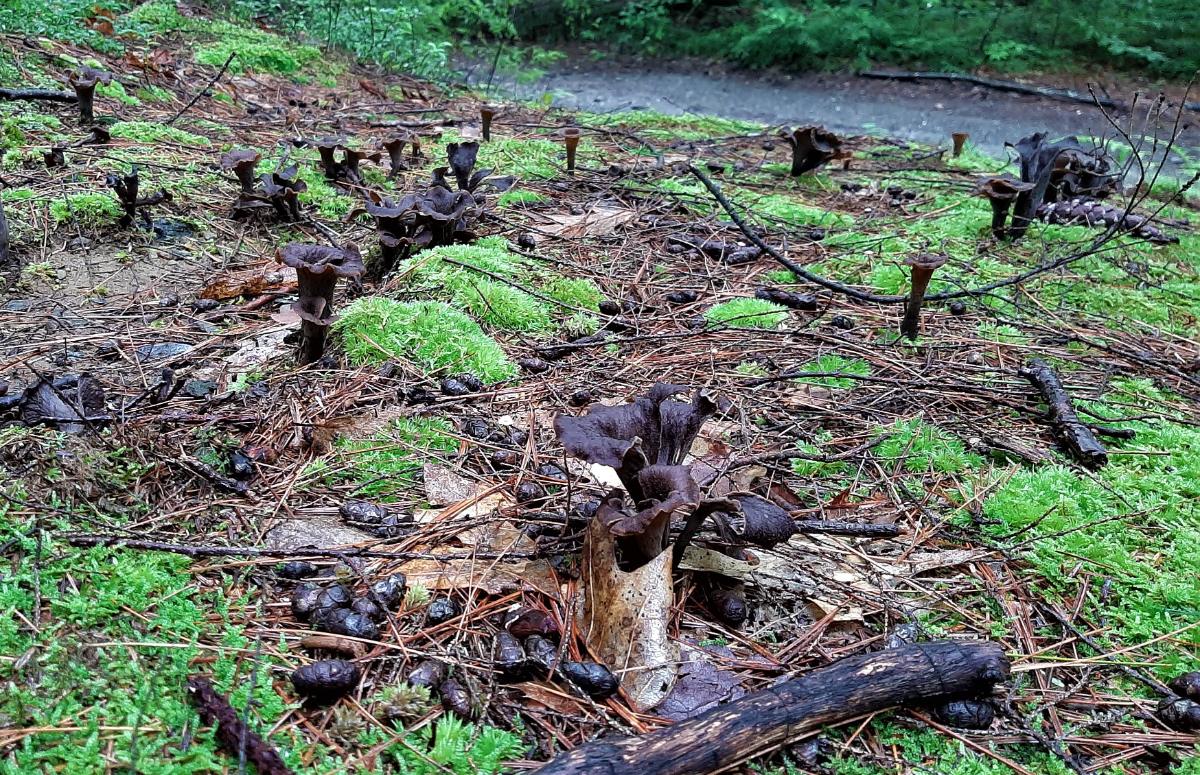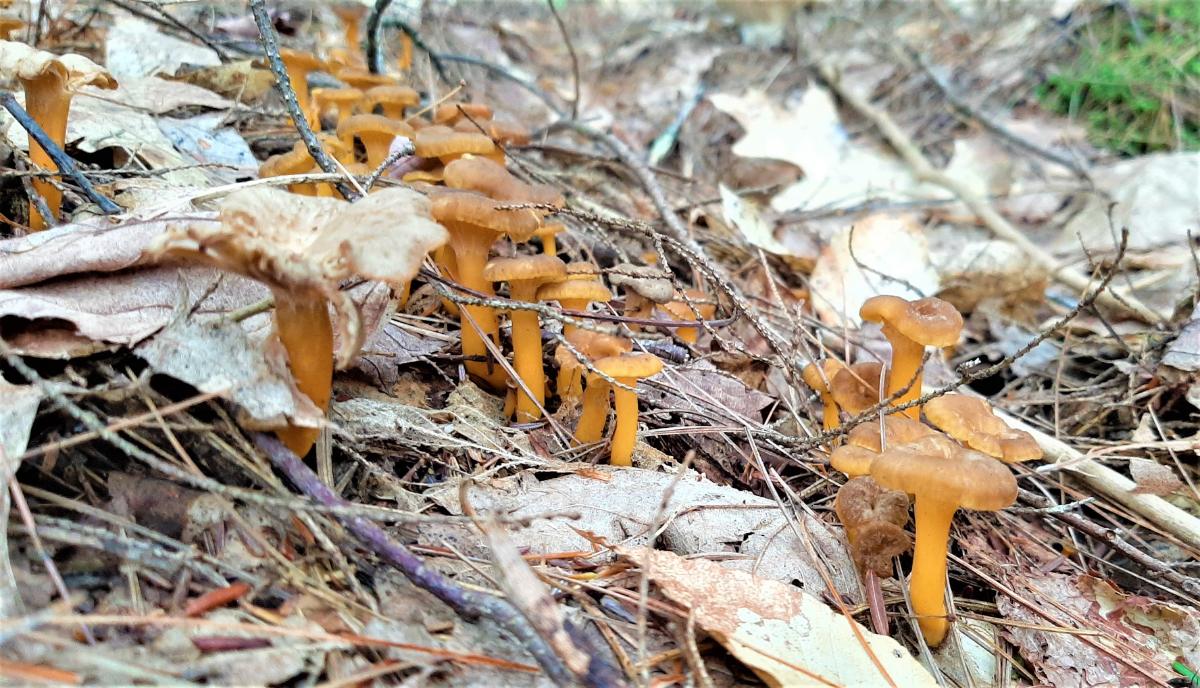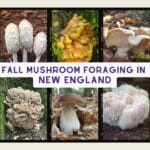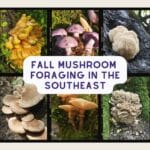Summer in the midwest is hot, muggy, buggy, and flush with edible mushrooms. Summer mushroom foraging in the midwest is often plentiful, with chanterelles, puffballs, hedgehogs, lobsters, and chicken of the woods all showing up. It’s fantastic if you can overcome the elements and wear lots of bug spray!
While you probably aren’t enjoying the mugginess, mushrooms love this weather. The best time to go out searching is 2-4 days after a good rain when the mushrooms have time to absorb it up and grow and before the bugs invade. Try not to be too disappointed about finding slug and bug-ridden mushrooms – use it as knowledge for next year. Many fungi return to the same location each year, so you’ll know to check a little earlier next year.
Of course, when you’re out in the woods, bring your bug spray – insect and tick spray is a necessity. We love these permethrin-treated socks (and other clothing)—they really work to keep the ticks away. Also, we don’t go in the woods without these mosquito head nets to protect our faces from the relentless mosquitos and black flies. They may look a little funny, but they’re worth it.
If I’m missing any midwest spring mushrooms, please let me know in the comments! Also, check out the guides for Fall Mushroom Foraging in the Midwest, Winter Mushroom Foraging in the Midwest, and Spring Mushroom Foraging in the Midwest.

Summer Mushroom Foraging In The Midwest
Chanterelles
The chanterelle is the sweet, fruity mushroom gem of the forest. It is densely textured, slightly sweet tasting, and absolutely delicious. Chanterelles love the summer humidity and often fruit in vast patches. The quintessential chanterelle is golden yellow, like an egg yolk lying on the forest floor. Not all chanterelles are golden, though.
Chanterelle’s prime season is July through early September, so if you want to find these, you have to get out looking throughout the summer. As with so many other mushrooms, they most likely show up after a good rain and will quickly become bug-homes if not found. Make sure you understand the difference between false chanterelles and true chanterelles before hitting the woods.
The midwest is home to quite a few chanterelle species. In fact, it seems to be the North American hotspot for chanterelle species! This list covers many of them, but there are still some that aren’t fully described to science and don’t have official names yet. If you’re finding chanterelles in the midwest, please consider participating in some citizen science and document your finds in iNaturalist and/or Mushroom Observer. Mycologists rely on these reports to figure out new species and their range.
- Cantharellus altipes – Golden yellow cap and false gills, likes sandy soil, and fruits in oak and pine forests.
- Cantharellus appalachiensis – Brownish-yellow cap, yellow false gills, and fruits with oaks and other hardwoods. This species is more common in the southern midwest states, and either doesn’t occur further north or is underreported.
- Cantharellus enelensis – Another yellow-brown chanterelle with orange to yellow false gills. It fruits in conifer forests and is hard to differentiate from other species without DNA analysis.
- Cantharellus flavus – A classic golden-yellow cap and false gills. It grows with hardwoods or in mixed forests.
- Cantharellus lateritius – Commonly known as the smooth chanterelle, this species has a smooth to slightly wrinkled underside instead of defined false gills. Its cap and underside are both golden yellow-orange, like the classic chanterelle. This species grows primarily with oak trees but will also fruit with hickories. It is more common in the lower midwestern states and either uncommon or underreported in the upper Midwest.
- Cantharellus minor – As the scientific name suggests, this chanterelle species is small compared to the others. It rarely gets more than 1.5 inches tall and has an orange-yellow cap and false gills. It fruits around oaks and other hardwood trees.
- Cantharellus cinnabarinus – This is the midwest’s red chanterelle. The cap is bright orange or red or flamingo pink. It is a small chanterelle, growing only up to 1.5 inches tall. It grows with oaks, beech, big-toothed aspen, and shagbark hickory.
If you’d live to dive more into the individual species of this mushroom, check out our guide Red, White, and Golden Chanterelles of the US: Identification Guide.

Chicken of the Woods
Chicken of the woods is one of the top edible mushroom species. It is also an excellent mushroom for beginner foragers because nothing else really looks like it. Chicken of the woods starts showing up in late spring and continues fruiting through summer and fall. But, it is more common later in summer and into fall. It also doesn’t follow a set fruiting schedule like many other species. Each individual fruiting seems to be on its own timeline, which can make it challenging to find reliably. But, if you do find one, mark the spot because it will return the following year.
It is a dense, meaty textured mushroom that is excellent fried, sauteed with garlic and butter, barbequed, and stir-fried. Contrary to some people’s assertion, chicken of the woods doesn’t actually taste like chicken. But it has a very similar texture and works as an excellent replacement for chicken in recipes.
There are a few species of chicken of the woods in the midwest. There is the classic bright orange to yellow variety, and there is also a lighter peachy-colored species. Both are edible and prime. Chicken of the woods grows in dense overlapping clusters on dead and dying wood.
- Laetiporus sulphureus – This is the classic bright orange and yellow chicken of the woods with yellow spores. It grows in dense clusters on hardwoods. It is most common on oak trees but will also fruit from poplar, willows, beech, locust, cherry, and pear.
- Laetiporus cincinnatus – While this chicken of the woods may look like it’s growing from the ground, it is actually growing from buried wood. This confuses a lot of people as it can often be found 5-6 feet away from a tree, but rest assured, it is attached to the tree roots beneath the soil. Because it is usually growing from buried wood, it also forms a bit differently from other chicken of the woods. Instead of stacked overlapping shelves, this species grows as a rosette. In addition, it also is peachy orange instead of bright orange or yellow and has white spores. This one really sets itself apart from the other chickens of the woods! You can find it growing around oak trees.
- Laetiporus huroniensis – This chicken of the woods looks just like the classic L.sulphureus, except it grows on conifers instead of hardwoods. It has bright orange or yellow caps and yellow pores.
To learn more about foraging this edible mushroom species, check out our guide, Chasing the Chicken of the Woods (Facts, Identification, and Recipes).

Black Trumpets
This cousin to the chanterelle can be tricky to find. Black trumpets are deep gray to black, trumpet-shaped, and smell rich and earthy. Their flavor is like no other species, which is why they’re so widely sought, even though there isn’t much to them. Because of their dark coloring, they tend to blend in with the leaf litter, unlike their chanterelle cousins who shine on the forest floor.
Black trumpet mushrooms are notoriously delicate, with thin, fragile flesh that easily falls apart in a foraging bag. If you’re hunting these mushrooms, bring along a separate brown paper bag or basket for them, as they won’t survive in a basket with other mushrooms.
These edible mushrooms are a mid- to late-summer species, and foraging these forest treats takes lots of patience, trekking through the woods, careful study of the topography—or just plain luck! They’re worth it, though! Their flavor is smoky, rich, earthy, and one-of-a-kind! If you find these, mark the spot in your map well because they return yearly.

Yellowfoot Chanterelles
The yellowfoot chanterelle might look familiar to you; it is also a cousin to the true chanterelle and looks extremely similar to it. Unlike most true chanterelles, though, this species is significantly smaller and not as brightly colored. The caps vary in color depending on the species but can be yellow-orange, yellow-brown, or just brownish.
Yellowfeet are a great edible species but not as amazing as most of the others on this list. The great thing about them, though, is that they usually fruit in huge, dense patches, and it’s easy to walk about with a lot of them. They taste a bit bland, but they are great for adding to soups, stews, stir-fries, and pizza toppings.
The primary difference between yellowfoot chanterelles and true chanterelles is their stem. Yellowfoot mushrooms have hollow stems; chanterelle stems are never hollow.
This forager commonly finds yellowfoot chanterelles fruiting in the same area, if not at the same time and place, as black trumpets (another mushroom relation). So, whenever you see yellowfeet, check around for black trumpets. Black trumpets usually fruit just a little bit later (but not always), so make sure to check back a few times throughout the season to see if the trumpets show up in the same vicinity.

Giant Puffballs
Puffballs, big and small, start showing up in mid to late summer. Finding a giant puffball is a dream forage, but the smaller puffballs are also edible and often prolific. You just have to forage a lot more of the small ones to get a meal. Puffball mushrooms are among the easiest to forage because they look quite distinct. However, you do have to be careful with the small ones because there are dangerous lookalikes that resemble small puffballs when they’re babies.
Giant puffballs, on the other hand, are one of a kind. Nothing else looks like someone left their volleyball sitting in the middle of a field! A foraged puffball will feed you for days. And, a lot of the time, there is more than one fruiting in an area, so you might end up with several of these monsters at once.
They’re not the best-tasting mushrooms but rather bland and airy in texture and flavor. But they take on other flavors really well and can be used much like tofu. They also dehydrate really well and can be used to bulk up soups and stews.

Lobsters
This genuinely bizarre mushroom species results from another fungi species being parasitized by this one. The lobster mushroom mycelium initiates this fantastic transformation, which creates a highly sought-after wild edible mushroom. Lobster mushrooms are a top edible mushroom species because of their thick, dense flesh and slightly sweet flavor.
Some people say they taste like ocean lobster, but that is a trick of the mind based on visual similarity. They are delicious, but they don’t taste like seafood. They sure look like it, though!
Lobster mushrooms fruit throughout the summer, and they’re usually pretty easy to spot due to their brilliant red or orange coloring. Except, sometimes they really try to hide under the leaf litter – always check out those mushhumps! A mushhump is a bump in the forest leaf debris that indicates there’s a mushroom under the duff, slowly pushing its way out. The great thing about this species is that it tends to reoccur in the same place every year, so if you find them, be sure to mark the spot.

Hedgehogs
Hedgehog mushrooms are sweet and nutty-tasting, with dense flesh. They’re also pretty easy to identify due to their unique teeth under the cap, where most mushrooms have gills. Hedgehogs might be small or large, depending on the exact species, and are sometimes bitter with age. It’s a good idea to always do a “nibble and spit” taste test with this family (don’t worry, there are no toxic ones) to make sure you don’t cook up a bitter mushroom by mistake.
Many people miss out on foraging hedgehogs because, from above, they’re rather plain-looking and easily overlooked. The tan to buff-white cap of the hedgehog mushroom is lumpy, undecorated, and often blends in with the surroundings. This is why we stop to inspect every mushroom, even if it looks boring from above.
Hedgehog mushrooms are a treat in the kitchen. Cooking brings out their sweet nuttiness, and they are excellent in stir-fries, sauteed with butter and garlic, or added to soups and stews.

Other Summer Mushrooms In The Midwest
You’ll probably stumble across lots of russula and milky cap species. These two look quite similar, and both have edible varieties in them. They’re not included in this list because most of them, even if edible, aren’t that fantastic. Some are decent, but not compared to the prime edible species listed above.
There are also a lot of boletes starting to show up in the forest. Make sure you read up on the boletes before foraging them. They can be tricky, though thankfully, not super dangerous; they just taste really bad if you get the wrong ones.










Leave a Reply